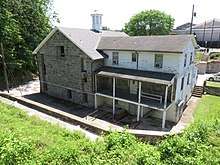Ellicott City Jail
The Ellicott City Jail was the first detention facility in Howard County, Maryland.


History
Ellicott City, Maryland, first housed inmates in a stone basement of a private residence on Fells lane. The "Thousand Dollar Jail" held as many as 15 prisoners in 4 cells without proper ventilation or drainage. The overcrowded facility conditions left prisoners unsegregated.[1] John H. Herbert Esq. petitioned for a new building in 1877. The existing jail was described as small, insecure, and defective in many ways[2]
In 1878, Howard County opened its first permanent jail facility on Emory road in Ellicott City. The granite building was designed to house twelve inmates. The building is an example of Romanesque revival architecture. It was named "Willow Grove" or Emory Jail.[3] The 1878 commissioners' names are inscribed in the stone (Samuel Brown, Jerome C. Berry, and Willam Rowles).[4] Eight cells were originally constructed, including "dark cells" which held condemned prisoners awaiting morning executions.[5]
In 1885, ten masked men broke into the jail, and lynched Nicholas Snowden, an inmate held for the murder of a young girl.[6]
By 1889, the jail was over capacity and housed 15 inmates under warden John Lilly.[7]
In February 1895, shop owner Daniel F Shea was murdered by Jacob Henson and Henson was sentenced to death. Fearing that Governor Brown might release Henson due to insanity, a group of residents broke into the jail and lynched Henson on Merricks Lane with a sign saying "Brown cannot rule our cort". Governor Brown condemned the citizens and ordered all condemned prisoners to the Maryland Penitentiary from then on.[8]
Despite orders from the governor to suspend capitol punishment at county facilities, prisoners were executed on site by hanging as late as 1916.[9][10]
In 1921, three prisoners escaped the jail by chipping away the mortar from a granite wall block with a piece of iron, and pushed the stone out for an opening.[11]
During World War II, the jail was used to house German POWs that were used as labor on local farms.[12] Prisoners were paid, but only received two meals a day with proceeds going to the sheriff for his own use. The conditions later prompted a congressional inquiry.[13]
On 18 April 1959, the building housed the Central Alarm operation in a top floor office.[14][15]
In 1975, a separate division was created by County Executive Edward L. Cochran. Its first director was Gerald H. McClellan. The jail was transferred to a new facility in Jessup in 1984. Within 10 years, Howard county raised its detention facilities from 12 to 360 inmates.[16]
The jail is unoccupied with most ironwork removed on a quarter-acre site. The slate roof was repaired with a temporary shingle roof. Asbestos removal costs are a contributing factor to the reluctance to maintain the historic structure.[17] In 2014 and 2015, Ellicott City Jail and the Hiene House was placed on the Preserve Howard top ten most endangered list due to walkway and parking lot construction plans.[18][19]
See also
- List of Howard County properties in the Maryland Historical Trust
- Howard County Circuit Courthouse
- Howard County Courthouse (Maryland)
References
- "Howard County Circuit Court: Progress of the Circuit Court--End of a Long Law Suit--Rising of the Grand Jury and Reports on the State of the Jail, Public Roads, and Free Negro Children--Young men's Christian Association". The Baltimore Sun. 29 September 1854.
- "A New Jail". The Ellicott City Times. 31 March 1877.
- Janet Kusterer, Victoria Goeller. Ellicott City. p. 43.
- Marsha Wight Wise. Ellicott City. p. 98.
- Howard County Historical Society. Images of America Howard County. p. 107.
- The Middlebury Register and Addison Journal. 25 September 1885. Missing or empty
|title=(help) - The Pittsburgh Dispatch. 24 March 1889. Missing or empty
|title=(help) - "Dragged to his death". The Baltimore American. 29 May 1895.
- "Waves to crowd as he goes to death". The Washington Herald. 5 August 1906.
- "Negro Murderers Hanged". The Hocking Sentinel. 26 June 1902.
- "Three Men dig way out of Maryland Prison". The New York Tribune. 24 January 1921.
- Joseph R. Mitchell, David Stebenne. New City Upon a Hill: A History of Columbia, Maryland.
- Congressional Record: Proceedings and Debates of Congress, Volume 91, Part 11.
- "Center for Emergencies". The Times. 31 March 1965.
- Howard County Historic Sites Inventory HO-54.
- "2012 Department of Corrections". Archived from the original on 4 January 2014. Retrieved 22 December 2013.
- "Ellicott City Jail". Archived from the original on 24 December 2013. Retrieved 22 December 2013.
- "Top 10 endangered historical sites in Howard County". The Baltimore Sun. 11 July 2014.
- Amanda Yeager (26 May 2015). "Former school tops Howard County's endangered sites list". The Baltimore Sun.